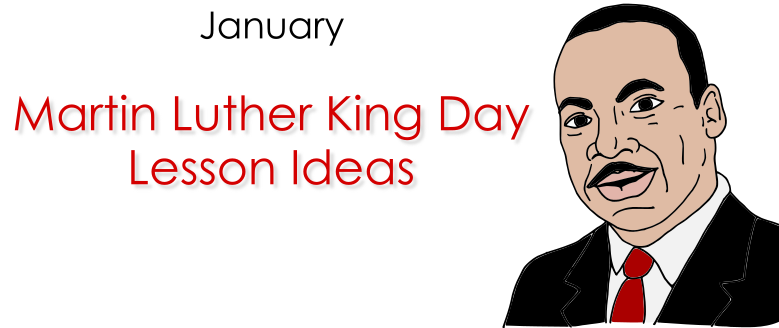“Let us not wallow in the valley of despair, I say to you today, my friends. And so even though we face the difficulties of today and tomorrow, I still have a dream. It is a dream deeply rooted in the American dream. I have a dream that one day this nation will rise up and live out the true meaning of its creed: ‘We hold these truths to be self-evident, that all men are created equal."
– Dr. Martin Luther King Jr.
There are few people in the history of the United States that have done more to advance civil rights than Dr. Martin Luther King Jr. He marched, spoke, was assaulted, arrested, and eventually killed for his activism and beliefs.
We remember him and his mission every year around January 15th, recognizing that students of all ages should learn the lessons in his struggle to ensure our country doesn’t repeat the mistakes of our past.
This week I put together a list of six lesson plans for educators to use this Martin Luther King Jr. day, and beyond.

While most of these lessons only require simple materials, a few require computers, projectors, and/or interactive whiteboards. Each lesson plan is paired with a materials list to help you decide whether it’s right for your classroom.
Let’s get started!
Lesson plans for MLK Jr. day
Grade level: K-5
1. Sequencing Events
This technology-dependent lesson walks students through the sequence of major events in Dr. King’s life and explores his impact as a leader of the civil rights movement. This lesson uses integrative whiteboards, BrainPOP videos, vocabulary words, and timeline charts to help young students gain a firm grasp on King’s historical lifetime.
Because of the dependence on technology, this lesson may fall out of reach for some schools. If your school already has the necessary materials, however, this is a useful and integrative lesson plan that will keep your students’ interest.
2. Dr. King’s Dream
This lesson introduces young students to the ideas and words of Martin Luther King Jr. through his famous “I Have a Dream” speech. Students will take what they learn about King’s life and work as a civil rights leader and create picture books based on their own dreams of freedom in the landscape of today’s America.
Covered topics include the “I Have a Dream” speech, King’s childhood, the March on Washington, and the meaning of Dr. King’s words. Standard art supplies (paper, crayons, markers, etc.), videos of various King speeches (easily accessible online), and images of civil rights marches are necessary for this lesson.
Grade level: 6-8
3. The Power to Persuade
Martin Luther King Jr. is one of history’s best orators and writers, with the power to change minds and hearts through not only his words but the delivery of them. This lesson teaches students about powerful and impassioned arguments through the lens of Dr. King’s “Letter from a Birmingham Jail”.
In this lesson, students write their own version of the letter, making their own arguments for desegregation of schools, restaurants, and buses, and share them with the class in an attempt to persuade each other to their point of view.
The only materials needed for this lesson are an excerpt of the letter provided in the link above (either projected in the classroom or provided via handouts) and individual sheets of paper for the students to craft their own letters.
4. Martin Luther King Jr. and the Power of Nonviolence
This lesson explores the importance of King’s philosophy of nonviolence and the impact of Mahatma Gandhi on King’s life and work. Students will learn how to apply this philosophy to current cultural and political issues by reading King’s writing on the subject, studying nonviolent protests, and discussing King’s writing in a group setting.
This lesson can be easily expanded into other cultures, such as Nelson Mandela’s work to end South African apartheid and his eventual rise to that country’s presidential office. The lesson plan links to additional resources that facilitate this expansion.
The only materials needed for this lesson are handouts of King’s and Mahatma Gandhi’s writings for the students.
Grade level: 9-12
5. I Have a Dream: Exploring the Nonviolence in Young Adult Texts
In this lesson, Students pull from the past and the present to explore nonviolence in conflict resolution. You’ll use the lyrics of the rapper Common and writer Walter Dean Myers to point to the lasting impact of Dr. King’s nonviolent activism and views.
After the lesson ends, students will have assigned homework reading: the short story “Monkeyman” by Walter Dean Myers.
For this lesson, you’ll need a computer to play King’s “I Have a Dream” speech and Common’s song “A Dream,” as well as a few handouts available through the lesson plan link above.
6. How Have Civil Rights Movements Resulted in Fundamental Political and Social Change in the United States?
This reading comprehension lesson is packed with critical thinking exercises and lesson review materials. Students study various civil rights movements—the 1960s civil rights movement, Cesar Chavez’s farmworkers' rights movements, and women’s suffrage—and identify the movement type and tactics used.
After the lesson, students break into groups to select a contemporary civil rights movement to analyze. They’ll break down the organization, objectives, and importance of civil disobedience within that movement.
The only necessary materials here are the linked lesson handout and an internet connection, making it a low-cost lesson plan ideal for cash-strapped teachers.
https://prezi.com/p/s5o_nio08x9g/the-life-of-dr-martin-luther-king-jr/
https://prezi.com/p/7rm52kd8mo3v/the-civil-rights-movement/
https://prezi.com/p/ytopyphmzaev/nonviolence-in-the-civil-rights-movement-when-king-met-gandhi/



0 comments:
Post a Comment
I would love to hear your feedback and suggestions. If you have any blog post ideas, please comment below and I will take it into consideration thank you. :)